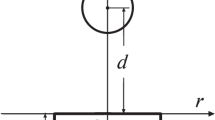Abstract
As is known, the collapse of vapor bubbles in a liquid can cause the intensive destruction of solid boundary surfaces. Experimental and theoretical investigations of bubble collapse have led to the conclusion that the surface of a bubble can deform and a liquid jet directed toward the solid surface can form in the process [1, 2]. In the theoretical reports [3, 4] too low jet velocities were obtained, inadequate to explain the destruction of the surface in a single impact. In [5] it was found as a result of numerical calculations that the formation of jets possessing enormous velocities is possible. It was also found that two fundamentally different schemes of jet formation are possible in the collapse of a bubble near a wall. The transition from one scheme to the other occurs upon a relatively small change in the initial shape of the bubble. In the present report we investigate the case of sufficiently small initial deformations of a bubble when the region occupied by the bubble remains simply connected during the formation of the jet; i.e., the separation of a small bubble from the bubble does not occur. In the case of the second scheme of bubble collapse near a wall the connectedness of the free boundary is disrupted and a small bubble separates off during the formation of the jet.
Similar content being viewed by others
Literature cited
M. Kornfeld and L. Suvorov, “On the destructive action of cavitation,” J. Appl. Phys.,15, No. 3 (1944).
R. T. Knapp, J. W. Daily, and G. Hammitt, Cavitation, McGraw-Hill, New York (1970).
O. V. Voinov and A. G. Petrov, “Motion of a sphere of variable volume in an ideal fluid near a solid surface,” Izv. Akad. Nauk SSSR, Mekh. Zhidk. Gaza, No. 5 (1971).
M. S. Plesset and R. B. Chapman, “Collapse of an initially spherical vapor cavity in the neighborhood of a solid boundary,” J. Fluid Mech.,47, No. 2 (1971).
O. V. Voinov and V. V. Voinov, “Scheme of collapse of a cavitation bubble near a wall and formation of a cumulative jet,” Dokl. Akad. Nauk SSSR,227, No. 1 (1976).
O. V. Voinov and V. V. Voinov, “Numerical method of calculating nonsteady motions of an ideal incompressible liquid with free surfaces,” Dokl. Akad. Nauk SSSR,221, No. 3 (1975).
M. Lenoir, “Numerical simulation of the collapse of a cavitation bubble,” Lect. Notes Phys.,59, 274–279 (1976).
Author information
Authors and Affiliations
Additional information
Translated from Zhurnal Prikladnoi Mekhaniki i Tekhnicheskoi Fiziki, No. 3, pp. 94–99, May–June, 1979.
Rights and permissions
About this article
Cite this article
Voinov, O.V. A calculation of the parameters of the high-speed jet formed in the collapse of a bubble. J Appl Mech Tech Phys 20, 333–337 (1979). https://doi.org/10.1007/BF00911690
Received:
Issue Date:
DOI: https://doi.org/10.1007/BF00911690



